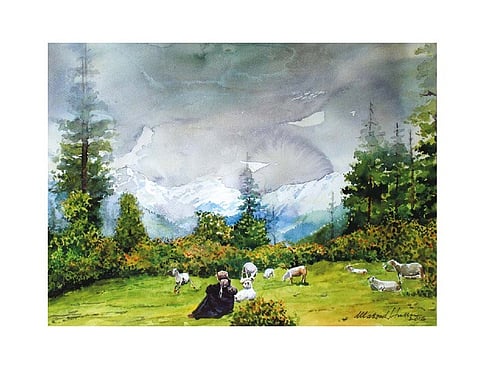

By Anuradha Bhasin
“If things do not turn out as we wish, we should wish for them as they turn out,” wrote Aristotle.
In ‘Love Letters to Kashmir’, an immensely beautiful jugalbandi of strokes and lyrics, Kashmiri artist Masood Hussain and Irish poet Gabriel Rosenstock come together. They do not sketch images of how they wish for things to be. They show them as they are in fine detail. Their magic is in enabling the reader/ viewer to gaze at places, moments, and forms differently so that through these visuals and matching texts can be absorbed the subtle intertwining of the earthly and the divine world for a truly exceptional and uplifting experience.
In 157 pages, 75 luminous water colour paintings and matching haikus[i], the book is an exhilarating journey of Kashmir’s mesmerizing nature, people, seasons, lanes, and shrines that calls our attention to the smallest details and makes one understand the world they illuminate. Through ordinary scenes of everyday life – the shepherds with their flock of sheep, women resting in a beautiful meadow and gazing into the mountains, empty streets, dilapidated houses with garlands of dried chillies hung on the walls, the crimson leaves of the autumn, the white almond blossoms, the shroud of snow, and much more – the paintings and the lyrics find beauty and divinity in anything and everything, imbuing boundless hope and positivity.
The book begins with the start of spring – the eternal symbol of hope and beauty. Masood Hussain with pink blossoms and mustard fields in the backdrop of misty mountains under a pink sky is matched by Gabriel Rosenstock’s:
at last, it is Spring
i’ll fill up the samovar
and You will join me
we’ll slowly sip namkeen chai
winter will be forgotten
The message of hope and beauty, however, remains the continuing thread even in the signs of darkness as the artist delves into the inner recesses of each image to bring back a sliver of beauty, accentuating it, showing you that the battle between darkness and light can be viewed as a triumph of light over darkness, assuring you that darkness is temporary.
On a snowy winter day, when the roads are covered in a blanket of white, a painting shows what meets the eye and what is hidden beneath. The poet asks:
the snow has covered it
all the blood on the street
is it over, Belovèd, the agony,
or is the world drifting
into the next bloody fray?
There’s a blend of beauty and divinity even in the most mundane activities.
A painting shows boatmen engaged in dredging Jhelum in a backdrop of silhouettes of distant trees, houses, and a shrine and broken images in the shiny waters of the river. The poem says,
here and there I drift
as in a swoon
I look in the river
it is Your face I see
smooth among the ripples
The paintings evoke passion through humanising worldly things like bicycles in a small alley, dilapidated walls, or an ordinary Samovar with the radiance of the hearth in the backdrop – finding in them a purpose, even in their stillness, even in their decaying, in their very existence.
The somber dullness of a dusky street with people beginning to return homes is painted in hues of purple. It isn’t just a daily evening ritual of the street that the artist paints, he expresses many emotions – of longing, separation, uncertainty, prayer, and hope.
The matching verse says,
when I look within
there is but dusk in my heart
melancholy spreads
come to me radiantly
You are radiance itself
The paintings and the poetry speak to you through the minutest details of real-life scenes in ways that make you gaze at the images repeatedly and re-read the words, immersing you into the depths of the spirit beneath each detail.
They make you listen to the beat of a heart…..as if telling a story, while reminding you that there is hope, there is hope and healing in beauty.
Like the concentric ripples in a pond, they engulf every part of Kashmir’s life and spiral out to encompass its mystique beauty.
Nothing about Kashmir would be complete without understanding the richness of its spirituality that gives its people the strength and resilience to endure and move on.
In one painting, Pigeons circle the still form of Srinagar’s Jamia Masjid, in its earthy tones, while in the streets, the believers go about their lives – walking, chatting, shopping from the make-shift shops.
The poet, writes, in response:
feathered ones
gather in anticipation
of the muezzin’s call
Belovèd, say that You hear me
I am lost in this world
Every stroke, and every word in this book is an ode to divinity and the core values of human existence: every stroke, and every word dances like the dervish. You can take a glance and feel refreshed or immerse yourself in their pristine beauty like meditation. Each page flashes upon, what Wordsworth called, the ‘inward eye’, long after you stop gazing, reading, and re-reading, lightening the soul and uplifting it in an enduring way.
[i] Gabriel Rosenstock has coined the word ekphrastic haiku to denote haikus in response to fine art landscape. He uses the terms ekphrastic haiku (in three lines) and ekphrastic tanka (in five lines) to mean “contemplative arts that are often prayer-like; and can sometimes express themselves as a meditative art.”
—–
Have you liked the news article?